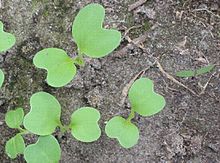Eudicotyledoneae
 Two seed leaves during germination
| ||||||||||||
| Classification scientific | ||||||||||||
| ||||||||||||
| Eudicotyledoneae Doyle & Hotton 1991[1] | ||||||||||||
| ||||||||||||
Eudicotyledoneae (ver dicotyledones) es le plus grande classe de plantas floral.
Phylogenia
[modificar | modificar fonte]Externe
[modificar | modificar fonte]Actual angiospermas se divide in sequente major gruppos:[2]
| Angiospermae |
| ||||||||||||||||||||||||||||||||||||||||||
Interne
[modificar | modificar fonte]Secundo le AGP IV classification, le cladogramma interne es le sequente:[6]
| Eudicotyledoneae |
| ||||||||||||||||||||||||||||||||||||||||||||||||||||||||||||||||||||||||||||||||||||||||||||||||
Referentias
[modificar fonte]- ↑ James A. Doyle & Carol Hotton 1991, Diversification of early angiosperm pollen in a cladistic context In book: Pollen and spores: patterns of diversification, Publisher: Clarendon Press, Oxford, Editors: S. Blackmore & S. H. Barnes, pp.169-195
- ↑ Guo, Xing (26 November 2021). "Chloranthus genome provides insights into the early diversification of angiosperms". Nature Communications 12 (1). doi:. PMID 34836973. Bibcode: 2021NatCo..12.6930G.
- ↑ 3,0 3,1 3,2 3,3 3,4 "The plant tree of life: an overview and some points of view" (October 2004). American Journal of Botany 91 (10): 1437–45. doi:. PMID 21652302., Figure 2 Archived 2011-02-02 at the Wayback Machine
- ↑ (2017) Plants of the World: An Illustrated Encyclopedia of Vascular Plants. University of Chicago Press, 114. ISBN 978-0-226-52292-0.
- ↑ "Five major shifts of diversification through the long evolutionary history of Magnoliidae (angiosperms)" (2015-03-18). BMC Evolutionary Biology 15 (1): 49. doi:. PMID 25887386.
- ↑ Angiosperm Phylogeny Group (2016). "An update of the Angiosperm Phylogeny Group classification for the orders and families of flowering plants: APG IV". Botanical Journal of the Linnean Society 181 (1): 1–20. doi:.






